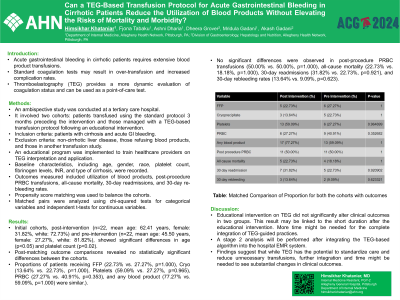Sunday Poster Session
Category: Liver
P1160 - Can a TEG-Based Transfusion Protocol for Acute Gastrointestinal Bleeding in Cirrhotic Patients Reduce the Utilization of Blood Products Without Elevating the Risks of Mortality and Morbidity?
Sunday, October 27, 2024
3:30 PM - 7:00 PM ET
Location: Exhibit Hall E

Has Audio

Himsikhar Khataniar, MD
Allegheny General Hospital
Pittsburgh, PA
Presenting Author(s)
Himsikhar Khataniar, MD, Fjona Tabaku, MD, Dheera Grover, MD, Mridula Gadani, MD, Akash Gadani, MD
Allegheny General Hospital, Pittsburgh, PA
Introduction: Acute gastrointestinal (GI) bleeding in cirrhotic patients presents significant clinical challenges, often requiring extensive blood product transfusions. Traditional transfusion based on standard coagulation tests may lead to over-transfusion. Thromboelastography (TEG), a point-of-care test assessing the viscoelastic properties of blood clots, offers a more dynamic evaluation of coagulation status.
Methods: This ambispective quality improvement study was conducted at a tertiary care hospital, involving two cohorts: patients transfused using the standard protocol three months preceding the intervention and those managed with a TEG-based transfusion protocol following an educational intervention. Cirrhotic patients with acute GI bleeding were included in this study. Outcomes measured were utilization of blood products (FFP, Cryo, Platelets, PRBC), post-procedure PRBC transfusions, all-cause mortality, 30-day readmissions, and 30-day rebleeding rates). Propensity score matching was used to balance the cohorts based on baseline characteristics, with matched pairs analyzed using chi-squared tests for categorical variables and independent t-tests for continuous variables.
Results: The proportions of patients receiving FFP (22.73% vs. 27.27%, p=1.000), Cryo (13.64% vs. 22.73%, p=1.000), Platelets (59.09% vs. 27.27%, p=0.965), PRBC (27.27% vs. 40.91%, p=0.353), and any blood product (77.27% vs. 59.09%, p=1.000) were similar. No significant differences were observed in post-procedure PRBC transfusions (50.00% vs. 50.00%, p=1.000), all-cause mortality (22.73% vs. 18.18%, p=1.000), 30-day readmissions (31.82% vs. 22.73%, p=0.921), and 30-day rebleeding rates (13.64% vs. 9.09%, p=0.623).
Discussion: The educational intervention on TEG did not significantly alter clinical outcomes between the groups. This could be linked to the short duration after the educational intervention. Another analysis will be performed after integrating the TEG-based algorithm into the hospital EMR system to further assess its impact on clinical outcomes. These findings suggest that while TEG has the potential to standardize care and reduce unnecessary transfusions, further integration and time are required to see substantial differences in clinical practice.
Note: The table for this abstract can be viewed in the ePoster Gallery section of the ACG 2024 ePoster Site or in The American Journal of Gastroenterology's abstract supplement issue, both of which will be available starting October 27, 2024.
Disclosures:
Himsikhar Khataniar, MD, Fjona Tabaku, MD, Dheera Grover, MD, Mridula Gadani, MD, Akash Gadani, MD. P1160 - Can a TEG-Based Transfusion Protocol for Acute Gastrointestinal Bleeding in Cirrhotic Patients Reduce the Utilization of Blood Products Without Elevating the Risks of Mortality and Morbidity?, ACG 2024 Annual Scientific Meeting Abstracts. Philadelphia, PA: American College of Gastroenterology.
Allegheny General Hospital, Pittsburgh, PA
Introduction: Acute gastrointestinal (GI) bleeding in cirrhotic patients presents significant clinical challenges, often requiring extensive blood product transfusions. Traditional transfusion based on standard coagulation tests may lead to over-transfusion. Thromboelastography (TEG), a point-of-care test assessing the viscoelastic properties of blood clots, offers a more dynamic evaluation of coagulation status.
Methods: This ambispective quality improvement study was conducted at a tertiary care hospital, involving two cohorts: patients transfused using the standard protocol three months preceding the intervention and those managed with a TEG-based transfusion protocol following an educational intervention. Cirrhotic patients with acute GI bleeding were included in this study. Outcomes measured were utilization of blood products (FFP, Cryo, Platelets, PRBC), post-procedure PRBC transfusions, all-cause mortality, 30-day readmissions, and 30-day rebleeding rates). Propensity score matching was used to balance the cohorts based on baseline characteristics, with matched pairs analyzed using chi-squared tests for categorical variables and independent t-tests for continuous variables.
Results: The proportions of patients receiving FFP (22.73% vs. 27.27%, p=1.000), Cryo (13.64% vs. 22.73%, p=1.000), Platelets (59.09% vs. 27.27%, p=0.965), PRBC (27.27% vs. 40.91%, p=0.353), and any blood product (77.27% vs. 59.09%, p=1.000) were similar. No significant differences were observed in post-procedure PRBC transfusions (50.00% vs. 50.00%, p=1.000), all-cause mortality (22.73% vs. 18.18%, p=1.000), 30-day readmissions (31.82% vs. 22.73%, p=0.921), and 30-day rebleeding rates (13.64% vs. 9.09%, p=0.623).
Discussion: The educational intervention on TEG did not significantly alter clinical outcomes between the groups. This could be linked to the short duration after the educational intervention. Another analysis will be performed after integrating the TEG-based algorithm into the hospital EMR system to further assess its impact on clinical outcomes. These findings suggest that while TEG has the potential to standardize care and reduce unnecessary transfusions, further integration and time are required to see substantial differences in clinical practice.
Note: The table for this abstract can be viewed in the ePoster Gallery section of the ACG 2024 ePoster Site or in The American Journal of Gastroenterology's abstract supplement issue, both of which will be available starting October 27, 2024.
Disclosures:
Himsikhar Khataniar indicated no relevant financial relationships.
Fjona Tabaku indicated no relevant financial relationships.
Dheera Grover indicated no relevant financial relationships.
Mridula Gadani indicated no relevant financial relationships.
Akash Gadani: Phathom Pharmaceuticals – Speakers Bureau.
Himsikhar Khataniar, MD, Fjona Tabaku, MD, Dheera Grover, MD, Mridula Gadani, MD, Akash Gadani, MD. P1160 - Can a TEG-Based Transfusion Protocol for Acute Gastrointestinal Bleeding in Cirrhotic Patients Reduce the Utilization of Blood Products Without Elevating the Risks of Mortality and Morbidity?, ACG 2024 Annual Scientific Meeting Abstracts. Philadelphia, PA: American College of Gastroenterology.
